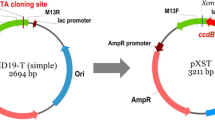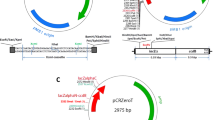Abstract
DNA cloning is the basic step for different fields of life science, and many efforts have been made to simplify this procedure. In this study, we report two general purpose plasmids (pGP), pGP-XB2E and pGP-B2E, for rapid and cost-effective construct of basic clones. The BciVI and XcmI cleavage sites are designed in pGP-XB2E to test plasmid linearization efficiency. The plasmid has better linearization efficiency by using BciVI which could almost completely digest 2 μg plasmid in 10 min with only one-tenth the recommended enzyme concentration. In order to further optimize the pGP-XB2E, a new plasmid, pGP-B2E, which removed XcmI cleavage site was designed. This vector is highly efficient for cloning PCR products up to 1812 bp, and the number of colonies was about five times that of pGP-XB2E. In addition to TA cloning, blunt-end PCR products with T ended in the primer could be positively linked to the T-vector pGP-B2E without A-tailing treatment (TB cloning). Moreover, as an entry vector, pGP-B2E was also compatible for gateway recombination reaction without frameshift mutations. In general, this vector provides a universal, quick, and cost-efficient method for basic molecular cloning.






Similar content being viewed by others
References
Yao, S., Hart, D. J., & An, Y. (2016). Recent advances in universal TA cloning methods for use in function studies. Protein Engineering, Design & Selection,29, 551–556.
Bellemare, G., & Potvin, C. (1991). Classification of type-II restriction endonucleases and cloning of non-identical cohesive-end fragments without self-polymerization using nonpalindromic oligodeoxyribonucleotide adapters. Gene,101, 67–74.
Eckert, K. A., & Kunkel, T. A. (1991). DNA polymerase fidelity and the polymerase chain reaction. Pcr Methods and Applications,1, 17–24.
Bielefeldt-Ohmann, H., & Fitzpatrick, D. R. (1997). High-efficiency T-vector cloning of PCR products by forced A tagging and post-ligation restriction enzyme digestion. BioTechniques,23, 822.
Aranishi, F., & Okimoto, T. (2004). Engineered Xcm I cassette-containing vector for PCR-based phylogenetic analyses. Journal of Genetics,83, 33–34.
Liu, Q., Dang, H. J., Wu, Y. H., Li, M., Chen, Y. H., Niu, X. L., et al. (2018). pXST, a novel vector for TA cloning and blunt-end cloning. BMC Biotechnology,18, 44.
Jo, C., & Jo, S. A. (2001). A simple method to construct T-vectors using Xcm I cassettes amplified by nonspecific PCR. Plasmid,45, 37–40.
Kovalic, D., Kwak, J. H., & Weisblum, B. (1991). General method for direct cloning of DNA fragments generated by the polymerase chain reaction. Nucleic Acids Research,19, 4560.
Ichihara, Y., & Kurosawa, Y. (1993). Construction of new T vectors for direct cloning of PCR products. Gene,130, 153–154.
Mead, D. A., Pey, N. K., Herrnstadt, C., Marcil, R. A., & Smith, L. M. (1991). A universal method for the direct cloning of PCR amplified nucleic acid. Biotechnology,9, 657.
Janner, C. R. (2013). pPCV, a versatile vector for cloning PCR products. Springerplus,2, 1–3.
Choi, J. Y., Jo, C., & Jo, S. A. (2016). Construction of a new T-vector: Nickase (Nt.BspQI)-generated T-vector bearing a reddish-orange indicator gene. Tissue Engineering & Regenerative Medicine,13, 66–69.
Hartley, J. L., Temple, G. F., & Brasch, M. A. (2000). DNA cloning using in vitro site-specific recombination. Genome Research,10, 1788–1795.
Bonsor, D., Butz, S. F., Solomons, J., Grant, S., Fairlamb, I. J., Fogg, M. J., et al. (2006). Ligation independent cloning (LIC) as a rapid route to families of recombinant biocatalysts from sequenced prokaryotic genomes. Organic & Biomolecular Chemistry,4, 1252–1260.
Li, M. Z., & Elledge, S. J. (2007). Harnessing homologous recombination in vitro to generate recombinant DNA via SLIC. Nature Methods,4, 251.
Li, M. Z., & Elledge, S. J. J. M. I. M. B. (2012). SLIC: A method for sequence- and ligation-independent cloning. Methods in Molecular Biology,852, 51–59.
Zhang, Y., Werling, U., & Edelmann, W. (2012). SLiCE: A novel bacterial cell extract-based DNA cloning method. Nucleic Acids Research,40, e55.
Motohashi, K. (2017). Seamless ligation cloning extract (SLiCE) method using cell lysates from laboratory Escherichia coli strains and its application to SLiP site-directed mutagenesis. Methods in Molecular Biology,1498, 349–357.
Sleight, S. C., & Sauro, H. M. (2013). BioBrick™ assembly using the in-fusion PCR cloning kit. Methods in Molecular Biology,1073, 19.
Zhu, B., Cai, G., Hall, E. O., & Freeman, G. J. (2007). In-fusion assembly: seamless engineering of multidomain fusion proteins, modular vectors, and mutations. BioTechniques,43, 354–359.
Bushman, W., Thompson, J. F., Vargas, L., & Landy, A. (1985). Control of directionality in lambda site specific recombination. Science,230, 906.
Celie, P. H., Parret, A. H., & Perrakis, A. (2016). Recombinant cloning strategies for protein expression. Current Opinion in Structural Biology,38, 145–154.
Karimi, M., Inzé, D., & Depicker, A. (2002). GATEWAY vectors for Agrobacterium-mediated plant transformation. Trends in Plant Science,7, 193–195.
Curtis, M. D., & Grossniklaus, U. (2003). A gateway cloning vector set for high-throughput functional analysis of genes in planta. Plant Physiology,133, 462–469.
Reece-Hoyes, J. S., & Ajm, W. (2018). Gateway recombinational cloning. Cold Spring Harbor Protocols. https://doi.org/10.1101/pdb.top094912.
Zhou, J., Wang, X. M., Chen, B., Chen, J., Yang, Y., Yu, C. L., et al. (2013). Low-cost gateway-compatible bimolecular fluorescence complementation assay system. Acta Agriculturae Zhejiangensis,25, 1024–1030.
Bernard, P., & Couturier, M. (1992). Cell killing by the F plasmid CcdB protein involves poisoning of DNA-topoisomerase II complexes. Journal of Molecular Biology,226, 735–745.
Qi-Jun, C., Hai-Meng, Z., Jia, C., & Xue-Chen, W. (2006). Using a modified TA cloning method to create entry clones. Analytical Biochemistry,358, 120–125.
Shaw, P. C., & Mok, Y. K. (1993). XcmI as a universal restriction enzyme for single-stranded DNA. Gene,133, 85–89.
Arashi, H. N., & Miwa, M. H. (1999). XcmI site-containing vector for direct cloning and in vitro transcription of PCR product. Molecular Biotechnology,12, 281–283.
Clark, J. M. (1988). Novel non-templated nucleotide addition reactions catalyzed by procaryotic and eucaryotic DNA polymerases. Nucleic Acids Research,16, 9677.
Marchuk, D., Drumm, M., Saulino, A., & Collins, F. S. (1991). Construction of T-vectors, a rapid and general system for direct cloning of unmodified PCR products. Nucleic Acids Research,19, 1154.
Motohashi, K. (2019). A novel series of high-efficiency vectors for TA cloning and blunt-end cloning of PCR products. Scientific Reports,9, 6417.
Nakagawa, T., Suzuki, T., Murata, S., Nakamura, S., Hino, T., Maeo, K., et al. (2007). Improved gateway binary vectors: High-performance vectors for creation of fusion constructs in transgenic analysis of plants. Bioscience, Biotechnology, and Biochemistry,71, 2095–2100.
Zhang, Z., Xu, Y., Xie, Z., Li, X., He, Z. H., & Peng, X. X. (2016). Association-dissociation of glycolate oxidase with catalase in rice: A potential switch to modulate intracellular H2O2 levels. Molecular Plant,9, 737–748.
Acknowledgements
This work was supported by the National Key Research and Development Program of China (2016YFD0100601-15), Zhejiang Provincial Foundation for Natural Science (LZ16C130002, LY16C140005, LY17C130007), and Zhejiang Fundamental Public Welfare Research Program (LGN19C140008).
Author information
Authors and Affiliations
Corresponding authors
Ethics declarations
Conflict of interest
The authors declare no competing or financial interest.
Additional information
Publisher's Note
Springer Nature remains neutral with regard to jurisdictional claims in published maps and institutional affiliations.
Electronic supplementary material
Below is the link to the electronic supplementary material.
12033_2019_226_MOESM1_ESM.tif
Supplementary material 1 (TIFF 1436 kb). Fig. S1. Flowchart for constructing pGP-XB2E vector with sequence information. (A) The flowchart of constructing pGP-XB2E from pGP-X2E. First step, two original BciVI recognition sites in the pGP-X2E backbone were removed to generate an intermediate vector. Second step, two new BciVI sites near the XcmI sites were introduced. The new vector was named as pGP-XB2E. attL1 and attL2, recombination sites; BciVI and XcmI: restriction enzyme recognition sites; Cm(R), chloramphenicol resistance gene. (B) The sequence of original BciVI sites in the pGP-X2E backbone and sequence after mutation in the intermediate vector. (C) The sequence of XcmI sites and XcmI-BciVI sites after mutation
12033_2019_226_MOESM2_ESM.tif
Supplementary material 2 (TIFF 793 kb).Fig. S2. The cloning workflow of pGP-XB2E. pGP-XB2E could be digested with XcmI or BciVI to generate a vector with 3′ T overhangs for conventional TA cloning. Target fragments with 3′ A overhangs were amplified by Taq DNA polymerase. attL1 and attL2: Gateway recombination sites
12033_2019_226_MOESM3_ESM.tif
Supplementary material 3 (TIFF 14146 kb). Fig. S3. Ligation efficiency comparison for different sized inserts. (A) TA cloning efficiency of BciVI linearized pGP-XB2E and pGP-B2E with fragments of 495 bp, 1110 bp and 1812 bp in length. (B) TB cloning efficiency of pGP-B2E with the same fragments in blunt end. Photographs of colonies on plates were shown as representative of each ligation
12033_2019_226_MOESM4_ESM.tif
Supplementary material 4 (TIFF 7038 kb). Fig. S4. Construction and ligation efficiency test of pGP-B2ES. (A) Sequence of the cloning site of pGP-B2ES. The yellow part represents the PCR product. The pGP-B2ES vector has shorter sequences between attL site and PCR product which was mutated from pGP-B2E. (B) Ligation efficiency of BciVI linearized pGP-B2ES using DNA fragments of 495 bp, 1110 bp and 1812 bp. The molar ratio of fragment/vector was 10:1. The number of colonies were calculated and expressed as mean ± SD from three independent experiments. (C) Photographs of colonies on plates were shown as representative of each ligation
Rights and permissions
About this article
Cite this article
Li, D., Zheng, C., Zhou, J. et al. pGP-B2E, a Recombinant Compatible TA/TB-Ligation Vector for Rapid and Inexpensive Gene Cloning. Mol Biotechnol 62, 56–66 (2020). https://doi.org/10.1007/s12033-019-00226-x
Published:
Issue Date:
DOI: https://doi.org/10.1007/s12033-019-00226-x




